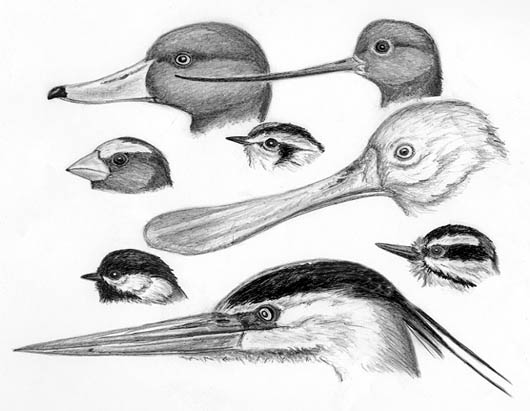
Dear Bird Folks:
For you, with your big mouth, this is not a problem, but how do birds like goldfinches, chickadees and sparrows crack open those jumbo sunflower seeds with their teensy little beaks?
-John, Brewster
Brewster Again John,
For some reason the vast majority of questions have been coming from Brewster lately. Seems as though everyone in Brewster is either very inquisitive or they all missed Bird Week in elementary school. Whatever, I’m happy to help and to….wait a minute, did you just call me a big mouth? Listen here buck-o, that’s pretty brave talk from someone who has apparently missed all of Bird Week. Don’t worry, I don’t really mind. This Red Sox thing has put me in my first good mood since 1918.
Last week I emphatically stated that wings were the feature that made birds stand out above all creatures. Well, that was last week and I was going through a dramatic phase. Now I’ve calmed down a bit and have reconsidered. While it’s true that wings are important, lots of creatures have wings. The beak is really the one thing that is unique to birds. Think about it, you really can’t name on other creature on the entire planet that has a beak, if you don’t count the octopus or Barbara Streisand.
Just a quick side note: the term beak and bill are interchangeable. Beaks and bills are one and the same. There, that should save me from having to answer about a hundred more letters from Brewster.
There is no doubt that the ability to fly is a huge advantage for birds, but having wings where arms and hands should be can lead to problems. Without hands birds struggle to climb, dig, gather and hit or catch a baseball (The last two apply to Cardinals from St. Louis only). Amazingly bird’s bills have adapted to that take the place of hands or paws. With their beak they can catch food, dig holes, build a nest, preen, care for young and defend themselves.
The variety of bird bill shapes and sizes are both varied and extreme. Each species has developed a bill that will allow it to exploit a particular food source. Warblers have tiny beaks that they use to pluck minute insects off tree branches. Woodpeckers don’t pluck but use their chisel bills to dig out insects buried deep inside trees or under the shingles of our houses. Many ducks have flat bills that they use to strain food out of pond water or mud. Shorebirds use their long bills to probe deep into the sand, while herons their longer bill to spear at fish. The obvious winner in this bill diversity race is the Roseate Spoonbill. Their odd shaped spoon bill makes them one of the few birds that can eat soup, without making a mess.
Finches and sparrows are seed eaters. They have cone shaped beaks that are extremely strong and powerful. Bird banders will tell you that even the sissy cardinal will draw blood if not handled properly. A grosbeak lives up to its name by having the ability to open seeds that are as hard as cherry pits. Besides being strong and powerful, most seed eaters also have sharp edges or grooves in their bill. It’s these sharp edges that help the birds split open the tough seeds or the bird bander’s hand.
Birds like chickadees and nuthatches don’t have those crushing finch beaks. They must hammer the seeds open. Chickadees hold the seed in their feet and hack away. Nuthatches on the other hand, who’s weird feet look more like skis, aren’t able to hold a seed They must jam the seed into a crevasse of a tree and “hatch” it open with their pointy bill. Even the beak of the muscle bound Blue Jay isn’t shaped correctly for snapping open seeds. They have their own way of feeding. Not wanting to look wimpy in front of the other birds, a jay will swallow many seeds whole, fly some place private, spit the seeds back up and then hammer them open like the chickadees do.
Believe it or not John, I’m not the only big mouth. Many birds have such tiny beaks that they must rely on their extra large mouths for obtaining food. Whip-poor-wills and nighthawks fly around in the dark, with their massive mouths wide open, scooping up whatever insects get in their way. These birds, like myself, have made a good living at being a big mouth, although I don’t enjoy sucking up the insects as much as they do.